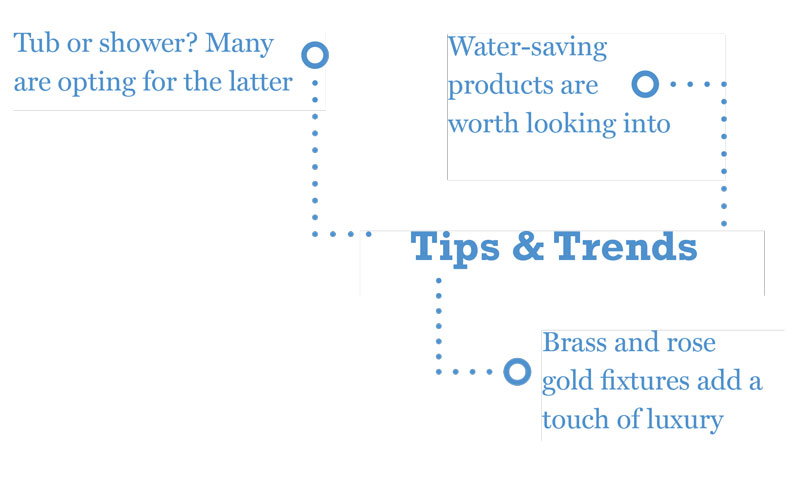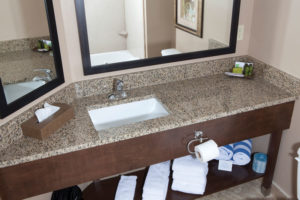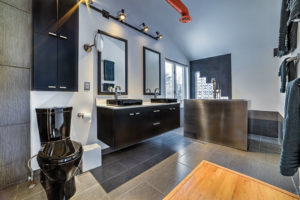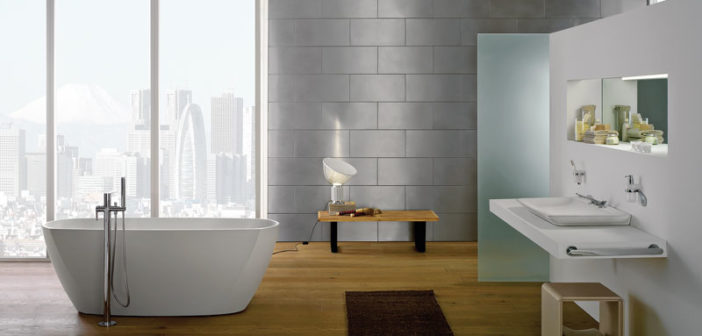 A luxurious, spa-like experience is one guests in all chain scales can appreciate.
A luxurious, spa-like experience is one guests in all chain scales can appreciate.
When it comes to bath design, “Excellent lighting, adequate counter space, and amenities to enhance the overall sense of relaxation are the three most essential considerations,” said Shelley Post, founder & senior consultant, Four Sisters Inns, noting that form and function should carry equal weights when making selections.
For her part, Leann Hendrix, senior interior designer, Thomas Hamilton & Associates P.C., noted, “Both [form and function]are equally important; however, form follows function, and we try to use regional resources to accent the style.”

Hotel Vanities International’s granite angled vanity has a rectangular undermount bowl with custom wood angled vanity bases.
“Key is choosing a product that is intuitive to what people are used to using,” said Suzanne Saunders, VP of design & construction, HVMG. “There are many trendy products that are released in a given year, and it is important that we consider the guest in the bath redesign. If the guest does not know how to use the product, then we’ve missed our mark, no matter how good the redesign.
“Our initial design approach is to create a timeless design that can transition over a period of several years,” Saunders continued. “Essential for us is creating an elevated shower and vanity experience. We are replacing the existing tubs and tub surrounds with a new natural stone or porcelain tile surround with frameless glass enclosed shower and installing an upgraded showerhead. The larger rain showerheads are more on par with what guests are using in their own homes. We are also installing decorative back-lit mirrors at the vanities. Lastly, rather than installing a swing bathroom entry door that every other hotel has, we are installing decorative sliding wood barn doors.”
“The bath has transitioned from a utilitarian space to a space for complete relaxation,” Post said. “Products designed to encourage lingering in the bath will be popular.” She pointed to mini refrigerators designed specifically for the resting area in the bath, comfortable seating, music and fireplaces.
What’s hot and what’s not? “Seventy-five percent of bathtubs are being replaced with showers by most hotels,” noted Hendrix. The other 25% are kept for ADA compliancy. “Also, open-plan bathrooms are losing momentum as many guests are not comfortable with this design.”
“Cabinets with doors are passé. Open shelving in lieu of hiding items in cabinets is both on-trend and more practical,” Post added. “We’re seeing more interesting stone for countertops now. Jetted tubs will continue to be popular, and brands emphasizing sanitary jet systems are going to have an edge. Hotel bathrooms will continue to grow larger.”

The SoDo collection from Strasser Woodenworks features a relaxed industrial look in a wall-mounted design.
“Neutral color schemes, back-lit mirrors with Bluetooth speakers, built-in storage and rain showerheads are all trending in hotel bathroom design,” Hendrix said.
For her part, Saunders said, “Brass and rose gold fixtures are back in style, and so is black (matte and stainless finish). We are also seeing wall and floor tile with textures, colors and patterns.”
Sustainability should also be a consideration. “Energy and water saving elements are extremely important in this era of environmental consciousness,” Hendrix said.
Post agreed. “We balance water conservation with the understanding that guests at our properties will want leisurely soaks in those inviting tubs,” she said. “We have low-flow toilets, water-saving devices on our showerheads and faucets, and we encourage people to be conscious.”
Saunders pointed to the business benefits of sustainable products. “Low-flow showerheads and toilets, as well as faucet aerators, can add up to a cost savings,” she said.


